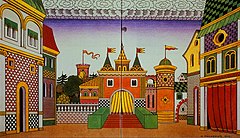Le Coq d'Or
| The Golden Cockerel | |
|---|---|
| Opera by Nikolai Rimsky-Korsakov | |

Ivan Bilibin's 1909 stage set design for Act 2: The Tsardom of Tsar Dadon, Town Square
|
|
| Native title | Zolotoy petushok (Золотой петушок) |
| Other title | Le coq d'or |
| Librettist | Vladimir Belsky |
| Language |
|
| Based on | Pushkin's "The Tale of the Golden Cockerel" (1834); 2 chapters of Washington Irving's Tales of the Alhambra |
| Premiere | 7 October 1909 Solodovnikov Theatre , Moscow, Russia |
The Golden Cockerel (Russian: Золотой петушок, Zolotoy petushok) is an opera in three acts, with short prologue and even shorter epilogue, by Nikolai Rimsky-Korsakov. Its libretto, by Vladimir Belsky, derives from Alexander Pushkin's 1834 poem The Tale of the Golden Cockerel, which in turn is based on two chapters of Tales of the Alhambra by Washington Irving. The opera was completed in 1907 and premiered in 1909 in Moscow, after the composer's death. Outside Russia it has often been performed in French as Le coq d'or.
Rimsky-Korsakov had considered his previous opera, The Legend of the Invisible City of Kitezh and the Maiden Fevroniya (1907) to be his final artistic statement in the medium, and, indeed, this work has been called a "summation of the nationalistic operatic tradition of Glinka and The Five." However the political situation in Russia at the time inspired him to take up the pen to compose a "razor-sharp satire of the autocracy, of Russian imperialism, and of the Russo-Japanese war."
Four factors influenced Nikolai Rimsky-Korsakov to write this opera-ballet:
Rimsky-Korsakov started work on his Golden Cockerel opera. It was finished in 1907. The opera was immediately banned by the Palace, and was not allowed to be staged. Rimsky-Korsakov’s health was probably affected by this, and he was dead by the time it was performed two years later.
The premiere took place on 7 October (O.S. 24 September) 1909, at Moscow's Solodovnikov Theatre in a performance by the Zimin Opera. Emil Cooper conducted; set designs were by Ivan Bilibin. The opera was given at the city's Bolshoi Theatre a month later, on 6 November, conducted by Vyacheslav Suk and with set designs by Konstantin Korovin. London and Paris premieres occurred in 1914; in Paris it was staged at the Palais Garnier by the Ballets Russes as an opera-ballet, choreographed and directed by Michel Fokine with set and costume designs by Natalia Goncharova. The United States premiere took place at the Metropolitan Opera House on 6 March 1918, with Marie Sundelius in the title role, Adamo Didur and Maria Barrientos in the actual leads, and Pierre Monteux conducting.
...
Wikipedia
